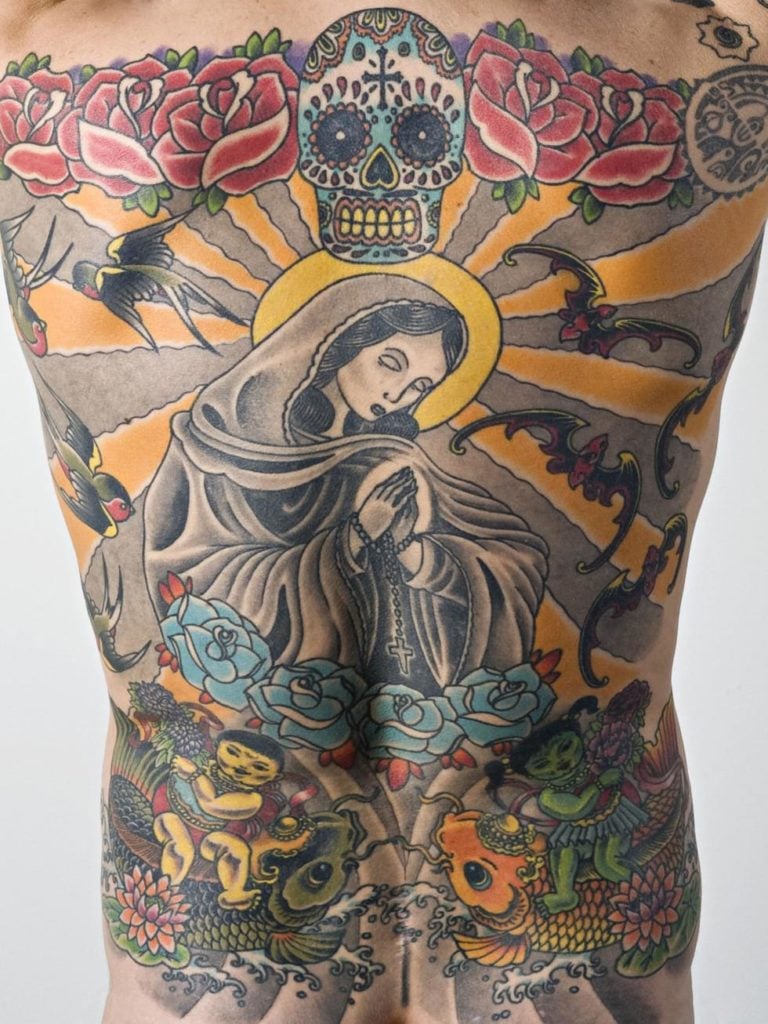Pop Culture
Oscar Nominee ‘The Man Who Sold His Skin’ Is Based on a Real Work of Art by Belgian Provocateur Wim Delvoye
Delvoye also makes a cameo in the Tunisian 'Best International Film' contender.

Delvoye also makes a cameo in the Tunisian 'Best International Film' contender.

by
Sarah Cascone

A real-life work of art is the inspiration for Kaouther Ben Hania’s The Man Who Sold His Skin, one of the 56 films nominated for the 93rd Academy Awards, taking place this weekend.
A tale of civil war, love, and cutting-edge contemporary art, the best international film nominee is a dark satire based on Wim Delvoye’s 2007 work Tim, in which the Belgian artist tattooed the back of a man named Tim Steiner, and sold it to a collector. Steiner got a third of the purchase price on the condition he sit in museum galleries during exhibitions of the piece, and that his skin be preserved and framed for the collector after death.
In the film, it’s a young Syrian refugee named Sam Ali (Yahya Mahayni) who becomes the living canvas, tempted by the prospect of a visa that will allow him to live in Europe, where he hopes to reunite with his love, Abeer (Dea Liane).
The Delvoye role becomes Jeffrey Godefroi (Koen De Bouw), who in the film is the world’s “most expensive living artist” who “turns worthless objects into works that cost millions and millions of dollars just by signing them,” according to breathless media coverage of his work.

Tim Steiner’s Wim Delvoye tattoo. Photo courtesy of Wim Delvoye.
Art world cognoscenti will spot the actual work of Delvoye in the museum exhibition where Sam is asked to sit for hours on end in the film. The artist even makes a cameo, playing the insurance agent who sells the collector insurance on the work. (Being a living work of art comes with unexpected conservation issues, it turns out—back acne to be precise.)
“I turned down the role of the artist because I am not a professional actor and I would not be able to do the job as well as the actor playing me,” Delvoye told Artnet News in an email. “I do regret this a bit because the film is much more successful than I expected.”
Sam meets Delvoye’s onscreen analogue when he is thrown out of a gallery opening by art dealer Soraya (Monica Bellucci) for eating too much of the wine and cheese (who hasn’t been there?) and is quickly tempted by the artist’s offer—not to sell his soul, but his back.
“We live in a very dark era where if you are Syrian, Afghan, Palestinian, and so on, you are persona non grata,” the Jeffrey character says in an interview after the work’s unveiling. “I just made Sam a commodity, a canvas, so now he can travel around the world. Because in the times we’re living in, the circulation of commodities is much freer than the circulation of human beings.”
The Faustian nature of this bargain—”sometimes I think I’m Mephistopheles,” Jeffery quips at one point—quickly becomes apparent, as Sam soon chafes at being treated like an object, rather than a person. Although the commodification of art affords a freedom denied Sam as a Syrian citizen, he remains in some ways just as powerless as before, appreciated primarily for the visa literally tattooed on his back.
And while the artwork grants him access to the art world elite who previously shunned him, Sam is still marked by “otherness” that sets him apart from the wealthy Europeans who gawk at his back during a cocktail party at the home of the collector who buys the work (the question of whether the artistic gesture is exploitation is very much a part of the film—but I won’t spoil it’s twists).
The movie adds additional layers of meaning to the original artwork—which was actually itself inspired by a film. “The fact Tim got sold is more important than the tattoo itself,” said Delvoye. “It is about commodification of art, humans, etc. But in this film it also deals with love, migration and so much else.”
The first Tunisian movie ever nominated for best international picture at the Oscars, The Man Who Sold His Skin offers a compelling, unique approach to the 21st century’s ongoing refugee crisis as well as a wry look at the contemporary art world.
“Art, as we know, is always exploring new unexplored territories,” Soraya tells a reporter asking about the sale of Sam’s skin. The Man Who Sold His Skin is a film that does just that.